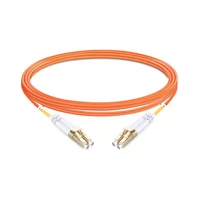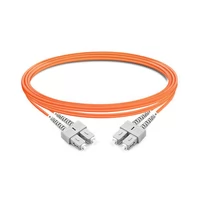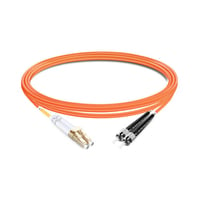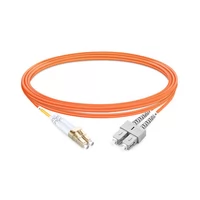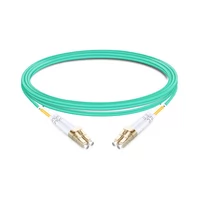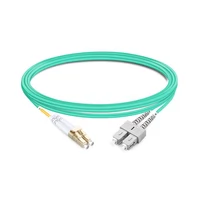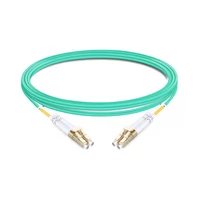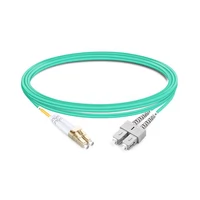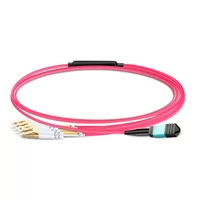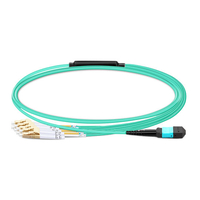Tracking and managing data center cabling is one of the most overlooked tasks in data center management. However, if not handled properly, it can lead to a variety of problems, such as causing everything from costly downtime to inefficient use of capacity.
Never compromise on “Cable spaghetti,” a complex tangle of cables from various electronic devices that takes a lot of time to sort through. This can be detrimental to the IT infrastructure, as improperly labeled and organized cables can prevent the effective identification of problems within the facility.
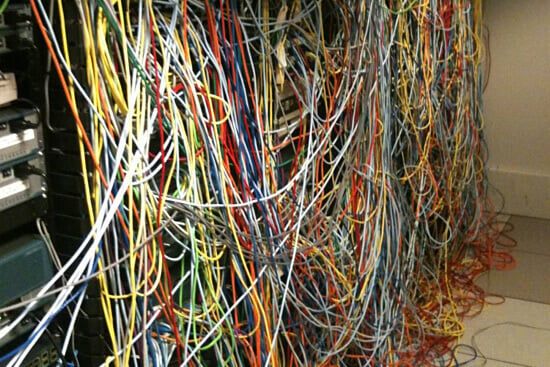
Table of Contents
ToggleWhat are the Hazards of Cable Spaghetti?
Signal interference. Power cables should be located on opposite sides of the rack, thus isolated from the data cables, to reduce the risk of electromagnetic interference (EMI). If the power and data lines in a parallel group or loop are too close together, EMI may occur, resulting in errors when transmitting data over the cable.
Obstacles to accessing rack components. The high density of cables in racks makes it difficult to access network components, servers, and other enclosed components. This can prolong troubleshooting and maintenance time, thereby reducing data center uptime.
Airflow restrictions. High-density cables can restrict airflow from components inside network enclosures. Blocked airflow from obstructed vents and fans can lead to overheating, equipment downtime, and severe equipment damage.
Productivity. The time spent sorting cables to resolve problems is time that can be allocated to other production processes. An effective cable management system with clearly marked and organized cables allows for timely problem resolution so that uptime is not interrupted.
That’s exactly why it’s so important to understand the basics of data center cabling, how to track and manage them, and how the industry’s best data center managers can dramatically simplify cable management.
What is Data Center Cabling?
Data center cabling is the process of connecting different parts of the data center infrastructure and equipment for network connectivity and power distribution.
Data center cabling can be divided into two main categories:
Structured cabling. Structured cabling is designed to follow predefined standards with pre-set connection points and paths based on the bandwidth requirements of the system. It is tested, organized, and labeled. At first, structured cabling can be expensive and time-consuming, but the benefits of increased operational efficiency, lower maintenance costs, and longer life far outweigh the alternatives.
Unstructured cabling. Unstructured cabling or point-to-point cabling lacks the standardized approach of structured cabling. With no predetermined design, unstructured cabling can often be installed cheaply and quickly, but it quickly leads to serious scalability and operational cost issues.
What is Data Center Cable Management?
Data center cable management is the marking, organizing, and documenting of the cabling infrastructure within a data center. The goal of data center cable management is to improve troubleshooting time, uptime, and capacity utilization.
Why is Data Center Cable Management Important?
Tracking and managing the data center cabling infrastructure can save time and money in a number of ways.
Maintain uptime. Accurate documentation of data center cabling makes it easier to respond quickly to problems and reduce downtime. Properly organizing cables eliminates the ” cable spaghetti phenomenon” that blocks access to racks and servers, enables optimal airflow, and makes cable tracing easy.
Improve capacity utilization. Knowing what cables and ports are available allows administrators to determine idle capacity, predict when it will run out, and make the most of available resources.
Increase productivity. Cable management enables faster, more informed decisions. Troubleshooting, performing an impact analysis, and executing moves, adds, and changes become easy when everyone has access to a highly accurate and real-time view of all physical assets and connections, and when cables are properly organized.
What Types of Cables are Used in Data Centers?
Modern mission-critical data center environments are complex, with a wide variety of cable, connector, and port types.
The following are the most common types of data center cabling.
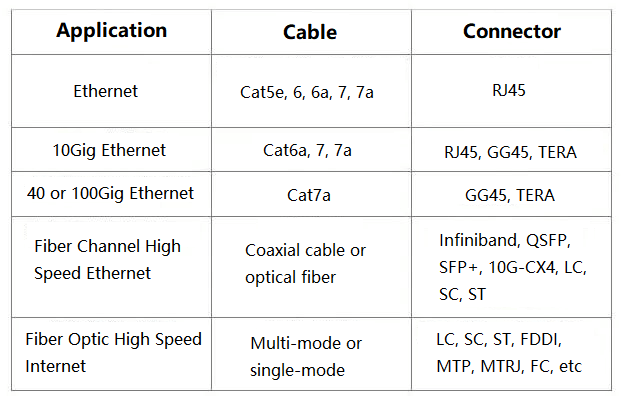
Is Copper or Optical Fiber Cabling Best for Data Centers?
When deciding whether copper or fiber is the right choice for a data center, there are some key parameters to consider.
Distance. Copper cables are best suited for shorter distances. They are usually sufficient to provide connectivity within the same rack. Optical fibers can cover greater distances at higher speeds to accommodate connections between devices in different racks.
Reliability and flexibility. Copper cable is highly reliable, with an average of 50 million hours of trouble-free time, allowing for maximum uptime. Optical fiber cables are lighter, thinner, and have a smaller bend radius than copper cables, providing greater flexibility in data center configurations.
Cost. The cost of copper cable is approximately 20-50% of that of fiber optic cable. When considering the size of a modern data center, the cost savings can be in the millions of dollars. Copper cables also require a small number of cooling resources because they use less power and have a thermal design. It is estimated that by using copper instead of fiber, data centers can save 100 kW of cooling energy.
Generally speaking, the best approach is to use a mix of copper and fiber cabling. Consider the unique circumstances of different data centers and consider using fiber where performance, flexibility, and distance are major factors and using copper elsewhere to reduce cabling costs.
What are the Data Center Cabling Standards?
Industry standards ensure security and provide guidelines for maintaining a high-performance cabling infrastructure.
The most common cabling standards for data centers are as follows.
ANSI/TIA-942 covers physical aspects of telecommunications infrastructure and data centers, such as site location, architecture, electrical systems, mechanical systems, safety, and security.
ISO/IEC 24764 specifies cabling to support the various communications services used within a data center.
ANSI/BICSI 002-2014 provides guidelines for data center design and operation. The guidelines cover planning, construction, security, management, maintenance, and efficiency.
ANSI/TIA 606-B is a labeling standard that helps identify and track cables.
How to Manage Data Center Cabling
Managing a cabling infrastructure does not require a lot of effort. By following a few basic principles, you will have well-documented and organized cabling that will enhance all aspects of data center management.
Label cables correctly. Perhaps the most basic and easiest way is organizing and labeling cables. Labeling simplifies troubleshooting and speeds cable tracing, making it easier to avoid downtime and increase productivity. Your labeling practices should include clearly labeling each cable, using a commercial-grade label manufacturer that allows you to import lists, and color-coding labels, and following labeling standards such as ANSI/TIA 606-B.
Ensure that cables do not restrict airflow. Remove all unused and discarded cables from under raised floors or inside cabinets. These unnecessary cables can block airflow and cause temperatures to rise, resulting in downtime or wasted energy due to inefficient cooling.
Keep cables cool. Everyone knows they need to cool their data center equipment, but it’s easy to forget that cables get hot too. If there are a lot of cables, the extra temperature can lead to power outages. Deploy and monitor temperature sensors to ensure that all equipment and cables are properly cooled.
Use cable managers. Cable ducts, cable loops, and cable ties are great for tightly bundling cables and making their paths easy to follow. Remember to first lay out the cables horizontally on the rack, bundle them up, and when the vertical space is reached, turn the bundle and lay it out vertically.
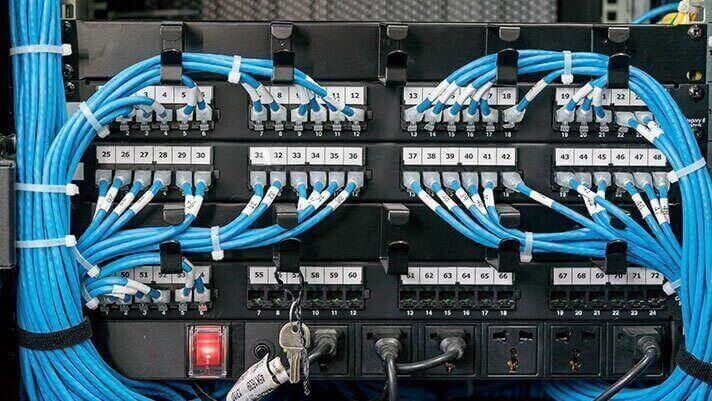
Know where to place the cables. If the data center is small and equipment is not replaced often, install cable bridges directly to the top of the rack. This is quick and easy to install. However, larger data centers will benefit from cable paths suspended from the ceiling. With it, racks can be moved or new racks can be installed without the need to realign cable paths.
Use wiring racks. Wiring racks help you organize large quantities of cables and provide greater flexibility in your network infrastructure. They can be installed in a rack and include blank ports on one side and termination points on the other. Cables can be easily terminated, tagged, and patched into the network hardware.
Maintain accurate documents. Track data and power circuits in real time to accurately plan capacity, perform failover analysis, and respond quickly to outages. The better your network documentation, the longer your uptime will be and the less time it will take to deploy new equipment. And with no need to physically trace cables, you can quickly reference documentation to understand what connects to what.
Deploy DCIM software. With DCIM software, data center cable management is easy, such as visually designing your cabling infrastructure, accurately documenting cabling installations, measuring cable lengths before purchase, and more.
Why is Data Center Cable Management Software Needed?
Modern data center sites need to manage a large number of IT assets, each with a large number of associated power and data cables. For example, a data center with an average of 100 racks will have over 70,000 individual cabling and port assemblies. These components must be accurately tracked and managed to efficiently perform moves, adds, and changes, understand port capacity, and resolve issues to reduce downtime.
In the past, data center managers relied on tools like Excel and Visio to manage their connections. We even had a free network documentation template. However, these tools can’t do the job in today’s complex, distributed data center environments. They are time-consuming, buggy, and difficult to manage.
Data Center Infrastructure Management (DCIM) software makes cable management easy. The second-generation DCIM tool has a large library of vendor models that provide the correct number of ports and specifications for each device you deploy. The system has built-in validation to ensure that all planned port connections can be implemented in the real world because they are compatible and available. Modern data center cable management software provides insightful reporting through zero-configuration analysis and 3D visualization, making it easy to understand port capacity and end-to-end cable paths.
Using DCIM software, you can reduce operational expenses by automating manual and time-consuming processes, such as measuring cable lengths. It can also eliminate the need to send technicians to the field to manually query available resources or to track and troubleshoot circuits. Capital expenditures can also be deferred through improved capacity planning and utilization of existing resources.
Conclusion
In summary, data center cabling cannot be ignored. Spaghetti cabinets and poor documentation can negatively impact the ability to solve problems and deploy new equipment while following best practices for data center connectivity management will improve uptime, efficiency, and productivity.
Related Products:
-
 1m (3ft) Duplex OM1 Multimode LC UPC to LC UPC PVC (OFNR) Fiber Optic Cable
$2.80
1m (3ft) Duplex OM1 Multimode LC UPC to LC UPC PVC (OFNR) Fiber Optic Cable
$2.80
-
 1m (3ft) Duplex OM1 Multimode SC UPC to SC UPC PVC (OFNR) Fiber Optic Cable
$2.80
1m (3ft) Duplex OM1 Multimode SC UPC to SC UPC PVC (OFNR) Fiber Optic Cable
$2.80
-
 1m (3ft) Duplex OM2 Multimode LC UPC to ST UPC PVC (OFNR) Fiber Optic Cable
$2.80
1m (3ft) Duplex OM2 Multimode LC UPC to ST UPC PVC (OFNR) Fiber Optic Cable
$2.80
-
 1m (3ft) Duplex OM2 Multimode LC UPC to SC UPC LSZH Fiber Optic Cable
$2.80
1m (3ft) Duplex OM2 Multimode LC UPC to SC UPC LSZH Fiber Optic Cable
$2.80
-
 1m (3ft) Duplex OM3 Multimode LC UPC to LC UPC OFNP Fiber Optic Cable
$3.00
1m (3ft) Duplex OM3 Multimode LC UPC to LC UPC OFNP Fiber Optic Cable
$3.00
-
 1m (3ft) Duplex OM3 Multimode LC UPC to SC UPC OFNP Fiber Optic Cable
$3.00
1m (3ft) Duplex OM3 Multimode LC UPC to SC UPC OFNP Fiber Optic Cable
$3.00
-
 1m (3ft) Duplex OM4 Multimode LC UPC to LC UPC PVC (OFNR) Fiber Optic Cable
$3.00
1m (3ft) Duplex OM4 Multimode LC UPC to LC UPC PVC (OFNR) Fiber Optic Cable
$3.00
-
 1m (3ft) Duplex OM4 Multimode LC UPC to SC UPC OFNP Fiber Optic Cable
$3.10
1m (3ft) Duplex OM4 Multimode LC UPC to SC UPC OFNP Fiber Optic Cable
$3.10
-
 1m (3ft) MPO UPC Female to 4 LC UPC Duplex OM4 50/125 Multimode Fiber Breakout Cable, 8 Fibers Type B, LSZH, Aqua/Violet
$23.00
1m (3ft) MPO UPC Female to 4 LC UPC Duplex OM4 50/125 Multimode Fiber Breakout Cable, 8 Fibers Type B, LSZH, Aqua/Violet
$23.00
-
 1m (3ft) MTP Female to 4 LC UPC Duplex OM3 50/125 Multimode Fiber Breakout Cable, 8 Fibers, Type B, Elite, LSZH, Aqua
$28.00
1m (3ft) MTP Female to 4 LC UPC Duplex OM3 50/125 Multimode Fiber Breakout Cable, 8 Fibers, Type B, Elite, LSZH, Aqua
$28.00

